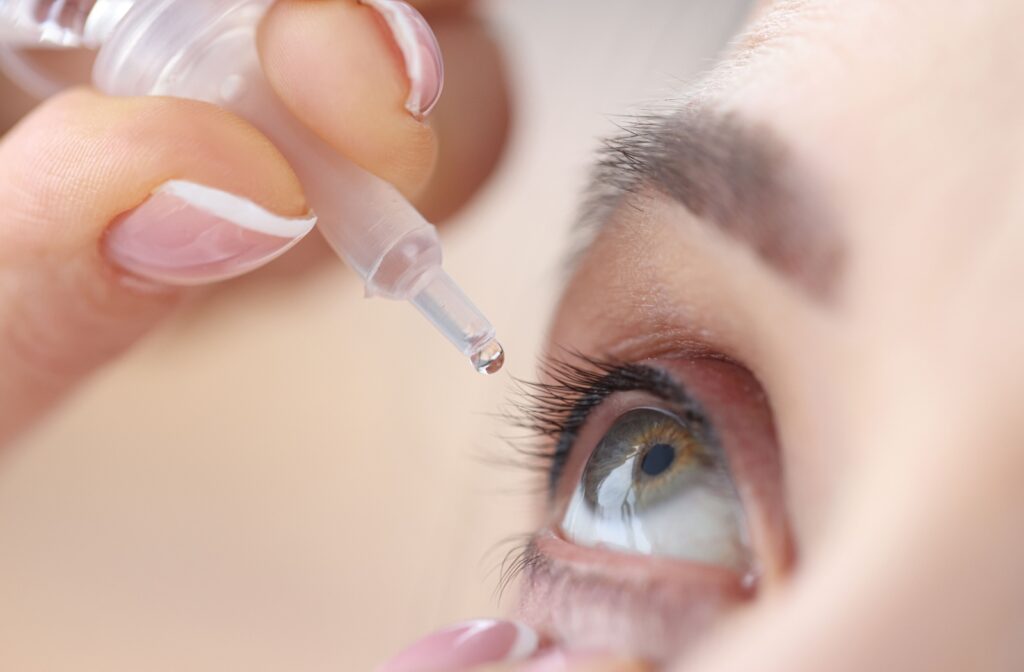Dry eyes are a common condition that can significantly impact daily life, causing discomfort, irritation, and even vision problems. One of the most accessible treatments for dry eyes is eye drops. But how often should you use eye drops for effective relief and eye health?
As a general guideline, you can use preservative-free artificial tears more than 4 times a day. How often you use eye drops can also depend on the severity of your dry eye and personalized recommendations by your eye doctor.
For a more in-depth look at dry eyes, we explore the causes, the importance of eye drops, recommendations on usage frequency, tips for application, and alternative treatment solutions.
What Is Dry Eye?
Dry eye is a surface eye disease that results when the eyes fail to produce enough tears or good-quality tears to maintain adequate lubrication. Sufficient and quality tears help keep the eyes moist, protect the eyes from foreign materials, and provide an even, smooth surface.
Various causes can lead to dry eye:
- Decreased tear production: Age, medical conditions, or certain medications can reduce tear production and lead to insufficient tears.
- Increased tear evaporation: Environmental factors such as wind, smoke, or dry air can cause tears to evaporate more quickly.
- Imbalance in tear composition: Tears have 3 layers—oil, water, and mucus. If there’s an issue with any layer, it can lead to dry eyes.
Triggers for dry eyes can vary but often include prolonged screen time without breaks or exposure to air conditioning or heating systems. Common symptoms of dry eyes can include:
- A stinging, burning, or scratchy sensation
- Stringy mucus in or around the eyes
- Sensitivity to light
- Redness of the eyes
- A sensation of having something in your eyes
- Difficulty wearing contact lenses
- Difficulty with nighttime driving
- Watery eyes
Eye Drops & How They Work for Dry Eyes
Eye drops, also known as lubricating drops or artificial tears, are designed to mimic the natural tears that keep your eyes moist and comfortable. They help lubricate the eyes, reduce irritation, and wash away foreign particles. Eye drops are generally the first management or treatment approach to dry eyes.
Types of Eye Drops
There are 2 types of over-the-counter eye drops, including the following:
- Eye drops with preservatives: These eye drops contain preservatives to prevent bacterial growth once you open the bottle. However, preservatives can cause eye irritation in some people.
- Preservative-free eye drops: These eye drops are ideal for those who require frequent application, as they are gentler on the eyes.
Frequency of Eye Drops Use for Dry Eyes
The frequency of eye drop use can vary depending on the severity of your dry eyes, such as mild, moderate, or severe. You can use eye drops with preservatives at least 4 times a day.
For chronic dry eyes, you might need to apply drops more frequently or as directed. You can use eye drops without preservatives more than 4 times a day. It’s essential to follow your eye doctor’s guidelines to avoid overuse, which can sometimes lead to decreased effectiveness or further irritation.
Tips for Effective Use of Eye Drops for Dry Eye
To get the most benefit from your eye drops:
- Wash your hands before applying eye drops to avoid introducing bacteria into your eyes.
- Check the expiry date for effectiveness and safety.
- Practice proper technique. Tilt your head back slightly, pull down your lower eyelid to create a small pocket, and place the drop in the pocket without touching the dropper to your eye. Close your eyes after applying the drop for 30 seconds to a minute to allow the drop to spread evenly.
- Follow the recommended dosage and avoid overuse to prevent potential side effects.
Other Dry Eye Treatment Options
In addition to using eye drops, consider the following treatments and lifestyle changes to help manage dry eyes:
- Prescription medications: Helps the eye produce natural tears and reduce inflammation.
- Take regular breaks. Follow the 20-20-20 rule: Every 20 minutes, look at something 20 feet away for at least 20 seconds.
- Stay hydrated: Drink plenty of water throughout the day to stay hydrated.
- Adjust your environment: Use a humidifier to add moisture and reduce exposure to wind, fans, or direct airflow.
- Wear protective eyewear: Sunglasses or wraparound glasses can help protect your eyes from wind and dust.
- Punctal plugs: Tiny devices placed in the drainage eye ducts help maintain tears in the eyes.
- Heat-based treatment: iLux® uses light-based heat to warm blocked oil glands and help restore tear function in dry eyes.
Management & Relief from Dry Eye
Dry eyes can be a bothersome condition, but with the right approach, you can manage the symptoms effectively for relief. Understanding the appropriate use of eye drops and incorporating lifestyle changes can significantly improve your eye health and overall comfort. If your dry eye symptoms persist or worsen, book an appointment with Focus West Optometry for personalized recommendations and treatment options.


